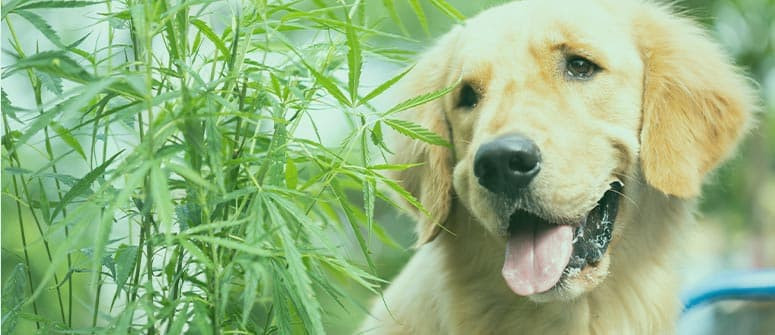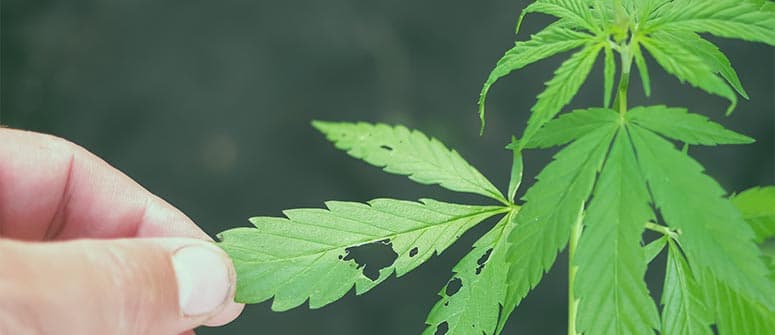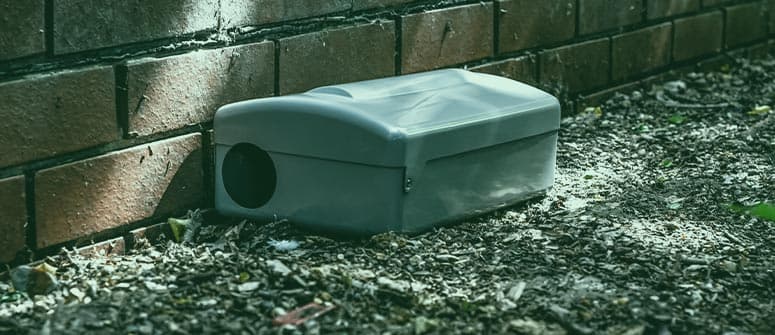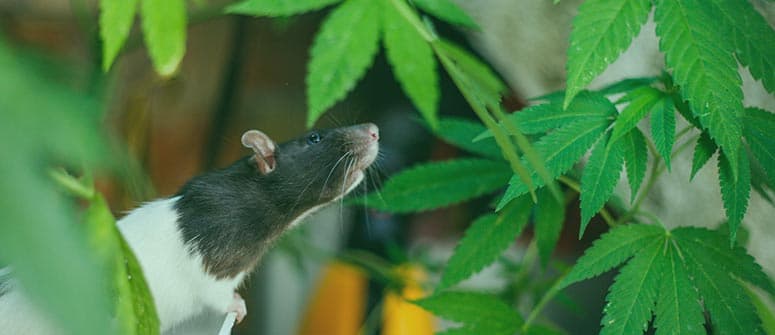How to animal-proof your cannabis garden

Protecting your cannabis plants from animals is super important, both for the health of your plants and any animals living in or near your home. Find out some of the main animal threats to your cannabis garden, and how to keep your grow free of these weed-loving critters.
Contents:
Many cannabis growers love animals… as long as they're far away from their crop. Unfortunately, both wild and domesticated animals can wreak havoc in a cannabis garden, and even suffer severe (sometimes fatal) consequences should they ingest cannabis plant material. So, for the safety of your green ladies and any animals near your garden, we'll teach you all you need to know about animal-proofing your cannabis garden below.
THE IMPORTANCE OF ANIMAL-PROOFING YOUR CANNABIS GARDEN

Animal-proofing your marijuana grow is super important for two main reasons.
First, you'll want to protect your plants from any potential damage caused by animals as they burrow around in the soil or nibble at leaves and stems. Animal faeces and urine can also introduce pests and toxic bacteria/pathogens into your garden or potentially cause nutrient burn due to high amounts of nitrogen and phosphorus.¹ As a cannabis grower, you want to give your plants the best growing conditions to maximise their health and yield potential—and having animals roaming around your garden can seriously compromise that.
Second—and just as important—you'll want to animal-proof your garden to avoid getting unwary critters high off of your supply. Just like humans, many animals have endocannabinoid systems, and are therefore susceptible to the intoxicating effects of THC and other cannabis compounds. Unlike with humans, however, getting high on marijuana can be risky business for animals. In uncontrolled doses, for example, THC can cause vomiting and deep sedation in dogs and cats, putting them at risk of choking or drowning in their own vomit.²
HOW TO PROTECT YOUR WEED GARDEN FROM ANIMALS

If you're growing indoors in a room or tent, there's a good chance that keeping the vents/openings of your grow space closed or covered is all it'll take to animal-proof your operation. If you're growing outdoor marijuana plants, however, animal-proofing is likely to be more hands-on. Below, we'll show you how to protect your crop from a variety of wild animals and your own pets.
RODENTS
Rodents, such as rats, mice, squirrels, and their relatives, are common in rural areas and big cities alike, and are always a concern for gardeners. First and foremost, rodents can carry all types of bacteria and pathogens that can cause serious risks for you and any other members of your household (especially pets like cats and dogs).
Second, rodents are notorious for gnawing at the stems of plants, causing considerable stress and leaving them vulnerable to disease, as well as damaging electrical wiring and building foundations. Thanks to their rapid breeding and large litters, the presence of a few rodents can quickly turn into an uncontrollable infestation that causes serious complications for your plants and your entire household.
SIGNS OF RODENT DAMAGE IN CANNABIS
- Droppings
- Damage to stems, branches, and leaves (from gnawing)
- Gnawing and holes in your pots, tent, room, or other parts of your grow space
- Scrabbling and scratching noises, especially at night or during "lights off"
- Foul odours from droppings, urine, or dead rodents
- Tracks in the soil, sand, or dust
- Cats or dogs showing particular interest in a part of your grow room or garden
RODENT-PROOFING YOUR CANNABIS GARDEN
To rodent-proof your garden, you'll want to secure its entire perimeter. If you're growing in a tent or room, this basically means sealing off any openings, including doors, windows, drainage, and air ducts. If you're growing outdoors, we recommend setting humane rodent traps, regularly patrolling your garden (especially at night), and letting your dog or cat out into the garden frequently to deter rodents.
DEER
Deer are majestic, peaceful creatures that can be breathtaking to observe. In an outdoor cannabis garden, however, they can be a nuisance. Deer are herbivores that love to feed on fresh, green vegetation. Moreover, they're creatures of habit, and tend to come back to graze in the same spots where they've been able to feed undisturbed in the past.³
While they typically steer clear from plants with strong scents, deer are known to visit gardens and eat pretty much any type of vegetation, especially when food is scarce. And if your plants are vegging and haven't yet developed much aroma, a single deer can cause serious damage to a marijuana plant, devouring entire branches in a single visit to your garden.
SIGNS OF DEER DAMAGE IN CANNABIS PLANTS
- Torn and broken branches
- Clean stems and branches with no leaves
- Deer tracks near your plants and around your garden
- Deer droppings
DEER-PROOFING YOUR CANNABIS GARDEN
The only way to protect your garden from deer is to instal a deer-proof fence. This can be done with mesh wire and posts, or classic wood privacy fences/hedges (at least 8m tall). Regularly patrolling your garden during twilight and letting your dog (if you have one) out into the garden will help to deter deer. Finally, you can spray your vegging plants with a mixture of vinegar, cayenne pepper, and garlic to deter deer and other foraging animals.
MOLES / GOPHERS
Moles and gophers are both burrowing animals that dig tunnels deep underground. While moles are found on every continent except Antarctica, gophers are endemic to North and Central America, where they are a common pest for gardeners and even commercial farmers. While moles typically have little interest in cannabis plants, and feed exclusively on earthworms and other small insects, gophers can pose a major problem as they'll feed on the roots of your plants as they tunnel, as well as forage on plant foliage and hoard it in their tunnels.
SIGNS OF GOPHERS
- Tunnel systems throughout your yard, with small burrow entrances surrounded by upturned soil
- As they dig, gophers may uproot small plants and shrubs
- Stunted plant growth and wilting, caused by the destruction of roots
- Gophers are larder hoarders and will tear up vegetation to transport back to their burrows
- Gophers may snatch up an entire young cannabis plant
GOPHER-PROOFING YOUR CANNABIS GARDEN
Moles typically won't disturb a cannabis garden, and you may even have a mole in your yard right now without knowing it. Gophers, however, are very destructive and need to be dealt with quickly in order to minimise damage to your plants. Cats and dogs are natural gopher predators, so letting your pets into your garden or tossing their faeces in or near the gopher mounds may motivate these harmful pests to abandon your garden. Castor oil, coffee grounds, and moth balls can also deter gophers due to their strong smell, as can planting gopher spurge (Euphorbia lathyris), daffodils, and marigolds around your garden. Gopher mesh can be installed under natural lawns to keep gophers from burrowing through it, while humane traps can be used to catch a gopher that has already settled into your garden.
RABBITS
Like gophers, rabbits love to dig, and can disrupt the soil around the base of your cannabis plants and potentially damage their roots. Rabbits also love feeding on leafy greens, and may gnaw at the stems of low-hanging branches of weed plants. Like moles, rabbits exist on all continents except Antarctica, and are a common pest for outdoor cannabis gardeners across the globe.
SIGNS OF RABBIT DAMAGE IN CANNABIS
- Burrows with large openings and disturbed soil
- Rabbit droppings around your yard and near your marijuana plants
- Signs of gnawing and chewing around the base of your plants and low-hanging branches
RABBIT-PROOFING YOUR CANNABIS GARDEN
Rabbits are notorious experts at breaking into yards and wreaking havoc on plants and soil. If you suspect your garden is getting regular visits from a cheeky rabbit, you should instal a fence around the perimeter of your grow space. Metal mesh fences designed for gardens, particularly those used to keep out small vermin such as rabbits, are ideal, but there's a myriad of alternative fences you can use, as long as they're durable and don't contain large gaps that a rabbit may fit through. Along with fencing, cage traps can also help you catch any rabbits in your yard and relocate them safely away from your crop.
FOXES
Foxes are another common pest facing gardeners and farmers the world over. These medium-sized omnivores are renowned for posing a threat to livestock, but they can be just as much of a nuisance for vegetable farmers or cannabis growers. Foxes are known to tear up plants and trample vegetation, burrow in soil, and mark their territory with urine and faeces. They are particularly attracted to soil that's fertilised with manure and blood/bone meal, and will tear up and destroy plants and their roots as they dig around looking for insects to feed on.
SIGNS OF FOX DAMAGE IN CANNABIS
- Trampled plants and seedlings
- Dug-up soil
- Torn-up plants
- A pronounced musky smell
- Droppings in prominent places, such as the centre of a garden (signs of foxes marking their territory)
- Upturned trash bags/cans
- Fox holes
FOX-PROOFING YOUR CANNABIS GARDEN
Foxes are particularly hard to deal with in outdoor gardens. Strong, durable fencing can be a start, but foxes are extremely agile and able to get under or over a variety of fences. Covering up any foxholes can help prevent a fox from making a permanent home (den) in your yard, and using non-animal-based fertilisers can also give foxes one less reason to come snooping around (as can keeping a clean garden). Finally, letting your dog regularly patrol your yard can help to deter foxes, as can ultrasonic deterrents.
RACCOONS
While native to North America, raccoons have also been introduced to areas of Europe and Asia. These intelligent and agile scavengers naturally maintain a meat-rich diet, but also eat some plants, meaning you might find them nibbling on your weed. In most cases, however, raccoons come into gardens in search of one of their favourite foods—earthworms. As they dig around the soil in search of their grub, raccoons can disturb and damage the roots of your plants, and are also known to tear up trash bags and trample plants as they scurry away upon detection.
SIGNS OF RACOON DAMAGE
- Deep holes dug in the soil or lawn
- Five-toed tracks around the garden
- Tube-shaped droppings at the base of plants and trees
- Scratching at fences and trees
- Signs of gnawing/nibbling at the base of your cannabis plants
- Looted trash bags/cans
RACCOON-PROOFING YOUR CANNABIS GARDEN
Unlike some of the other pests on this list, raccoons are fairly simple to keep out of your soil; just remember to regularly spray your topsoil with diluted castor oil (once every 1–2 weeks should be enough). Thanks to their super-sharp sense of smell, raccoons will be able to detect the oil's distinct aroma from afar and will likely avoid visiting your yard.
BIRDS
Having birds present in your cannabis garden can be a blessing and a curse. On the one hand, birds are one of the most effective ways to control a variety of insect pests, including grasshoppers, beetles, weevils, and caterpillars, that may feed off and stress your cannabis plants. On the other hand, birds have a big (and we mean really big) appetite for cannabis seeds. In fact, lots of store-bought bird food contains hemp seeds. If your green ladies happen to get pollinated, which often occurs in large outdoor gardens, you may find birds picking away at the seeds, destroying the flowers.
SIGNS OF BIRD DAMAGE IN CANNABIS PLANTS
- Bird droppings
- Seeing birds in your yard and on your cannabis plants
- Missing cannabis seeds from pollinated female plants
- Torn-apart cannabis flowers
BIRD-PROOFING YOUR CANNABIS GARDEN
If you're breeding cannabis outdoors, one of the best ways to keep birds away from your plants is to use netting. Alternatively, try letting your cat out into the yard during twilight (which is when most birds are most active).
CATS / DOGS
Like birds, cats and dogs are a double-edged sword for most cannabis growers. Besides the love pet owners have for their furry friends, we've shared multiple examples of how dogs and cats can help to protect your cannabis garden from a variety of pests and animals. Unfortunately, many animal-loving cannabis growers have seen their plants fall victim to their own pets digging around in soil, urinating/defecating near the roots of plants, or chewing at shoots and fresh foliage.
SIGNS OF CAT / DOG DAMAGE
- Dug-out holes in lawns, garden beds, or pots
- Cat and dog faeces around the garden
- Strong smell of urine
- Nutrient burn (cat and dog faeces/urine is rich in nitrogen and phosphorus)
CAT/DOG-PROOFING YOUR CANNABIS GARDEN
The best way to cat/dog-proof your cannabis garden is—you guessed it—not letting your pets near your cannabis plants. Investing in a grow tent, for example, is a great way to keep your plants out of the reach. Alternatively, in an outdoor garden, consider separating your cannabis plants with a fence, or using netting to protect the upper parts of your plants while using plastic mesh to deter your pets from digging around the base.
PROTECT YOUR GARDEN FROM WEED-LOVING CRITTERS

When we think of cannabis pests, we tend to think of thrips, red mites, fungus gnats, and the myriad other insects that often plague marijuana plants. But as we saw in this article, larger animals can be just as damaging to your weed crop (if not more so). If you happen to run into rodents, rabbits, deer, gophers, or other animals in your cannabis garden, make sure to follow the above tips to deal with them quickly and effectively.
References:
1. Schwarz, A. Is Cat Poop a Good Fertilizer for Flowers and Grass? Lawncare Guides. February 21, 2021. Accessed June 13, 2022. https://lawncareguides.com/is-cat-poop-good-fertilizer/
2. Charito, B. As Weed Becomes Legal In Chicago, Make Sure You Hide Your Stash From Your Dog. Block Club Chicago. July 8, 2019. Accessed June 13, 2022. https://blockclubchicago.org/2019/07/08/as-weed-becomes-legal-in-chicago-make-sure-you-hide-your-stash-from-your-dog/
3. Smith, J. Do Deer Eat Cannabis Plants? DeerBusters Canada. August 19, 2020. Accessed June 13, 2022. https://www.deerbusterscanada.ca/blogs/news/do-deer-eat-cannabis-plants




